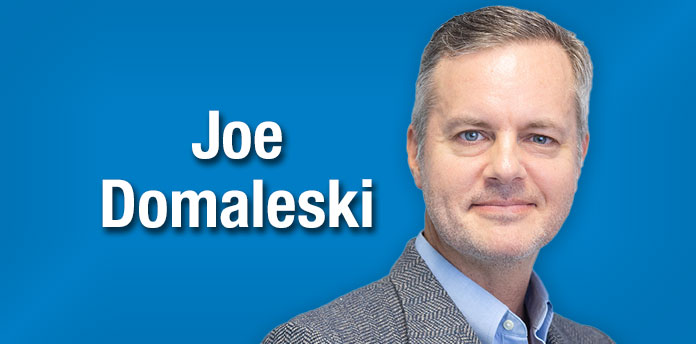Happy Holidays and hello, winter. It’s Christmas for some, Hanukkah, Kwanzaa, and Winter Solstice for others. No matter what you celebrate, it’s customary to gather together with our families as we wind down the year. This time of year is not only a time of celebration, but for me personally, it’s usually a time of reflection and planning. For some reason, we’re either around a lot of people during the holidays attending parties, dinners, and gatherings, or it’s just my wife, Mary Catherine, and me in a quiet house. I love being with family, but I also enjoy periods of solitude.
During periods of quiet, I normally try to work on some things around the house and get caught up on my personal “to do” list. What I look forward to the most, however, is some quiet time to just sit and think. Years ago, I learned how to be more deliberate about thinking after reading a book entitled “Thinking for a Change” by John C. Maxwell.
“Your thinking, more than anything else, shapes the way you live. It’s really true that if you change your thinking, you can change your life.”
– John C. Maxwell
Maxwell, perhaps best known for his books “The 21 Irrefutable Laws of Leadership” and “Developing the Leader Within You,” is one of my favorite leadership authors. Twenty years ago (the same year I started my business), he actually came to Fayette County and did a national broadcast originating from the newly established New Hope Church South Campus. Perhaps some of you reading this were there that day, it was a huge crowd.

While I was there at the Maxwell event, I picked up one of his lesser-known titles, “Thinking for a Change.” The message was simple, but it quickly became one of my favorites of his many books. His emphasis on the power and potential of “just thinking” really inspired me to be more deliberate about how I approached thought.
In the book, Maxwell makes the case that all actions and endeavors begin and end with thought. He maintains that there are different types of thinking skills and outlines each one of them in the book. Here’s a quick summary of those key skills and what they mean to me personally:
Big-Picture Thinking: Seeing beyond the day-to-day to understand the broader scope and future direction of my business and my life. I probably struggle with this more than any other type of thinking. It’s hard to think about the big picture when you’re drowning in the details of “here and now.”
Focused Thinking: Applying concentration and focus on key goals and challenges in order to make decisions and solve problems. I actually enjoy this type of thinking the most, but I have to be deliberate about tuning out distractions from emails, messages, and other non-urgent things that sometimes feel urgent.
Creative Thinking: Coming up with new ideas to drive innovation. Creativity allows individuals and organizations to develop new ideas, products, and services, which can lead to breakthroughs, excitement, and forward progress. This is what my company is best known for, and it’s actually part of our company name – Country Fried Creative. For me personally, the challenge isn’t the creativity part (because I have a great creative team) but it’s the application of that creativity to specific situations.
Realistic Thinking: Assessing situations objectively with facts, data, and experience. Oftentimes creativity is tempered with reality. Brainstorming shouldn’t be constrained by reality, but reality definitely comes into play before implementing ideas. As a business owner, I have to assess the feasibility and market potential of our creative ideas. Realistic thinking gives us the proper context for doing that.
Strategic Thinking: Planning effectively to achieve goals and objectives. This is different from big-picture thinking, which often isn’t constrained by goals and objectives. Strategic thinking considers various scenarios and paths. I often consider the best case, worst case, and probable case when it comes to strategic thinking. Risk vs. reward comes into play when considering strategic thinking.
Possibility Thinking: Empowers people to look beyond apparent constraints, envisioning what could be achieved. For me, this is the classic “Can Do” thinking where anything is possible. It’s all about being a leader of hope.
Reflective Thinking: Taking time to ponder and learn from past experiences. I do this a lot, perhaps too much. While it’s important to consider the past, it’s even more important not to dwell on the past in such a way that it becomes baggage. Experience gleaned from reflective thinking helps in realistic thinking to avoid past mistakes. However, focusing too much on the past can limit possibility thinking and future potential.
Going beyond popular thinking: Challenging the “crowd mentality” in order to see and do things differently. Unfortunately, this has become increasingly hard to do as computer algorithms dictate what we see. This means not just following the path well-trodden but daring to think independently. It’s about questioning the status quo and considering alternative perspectives or solutions that might not be immediately obvious or widely accepted.
Shared Thinking: Collaborating with others can help expand perspectives and generate better ideas. There are so many tools available to facilitate collaboration that it would seem this would be a “no-brainer.” Yet, each one of us works differently in a group setting. Optimizing frictionless collaboration without stifling group creativity is probably one of the top business challenges of our time. Work-at-home vs. work-at-the-office is a hot topic with businesses. I personally think a combination of in-person and remote collaboration has worked best with our team.
Unselfish Thinking: Focuses on how things affect others, including employees, customers, family, and members of the community. In business school, I was taught that the purpose of a company is to maximize profit. While profitability is important for financial viability, I’ve come to learn that a business has a moral obligation that goes beyond profits. For me, simply considering the question “How can this idea help people?” can lead to thinking that can help people and the community at large. Purpose first, and then profits often follow.
Bottom-Line Thinking: Concentrates on thoughts and activities that can generate measurable results. Being results-oriented is an important part of being a leader. Out of necessity, sometimes those results need to be immediate and short-term, like achieving year-end financial goals. At other times, the results are more long-term and sustainable in nature. Focusing on results ensures that big-picture, possibility thinking can lead to positive outcomes that are beneficial to all concerned.

If you’re like me, then perhaps you’ve never really thought about thinking. “Thinking for a Change” was a real eye-opener for me. Embracing Maxwell’s thinking styles, from big-picture to bottom-line thinking, isn’t just about business success; it’s also about enriching every aspect of our lives. May your holidays be merry, reflective, and filled with thoughtful moments. Enjoy your holiday family time, but create some space for thoughtful, deliberate, and creative thinking. Happy New Year, everyone – let’s make it a thoughtful one!
[Joe Domaleski, a Fayette County resident for 25 years, is the owner of Country Fried Creative – an award-winning digital marketing agency located in Peachtree City. His company was the Fayette Chamber’s 2021 Small Business of the Year. Joe is a husband, father of three grown children, and proud Army veteran. He has an MBA from Georgia State University and enjoys sharing his perspectives drawing from thirty years of business leadership experience. Sign up for the Country Fried Creative newsletter to get marketing and business articles directly in your inbox. ]









Leave a Comment
You must be logged in to post a comment.